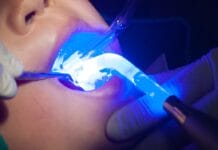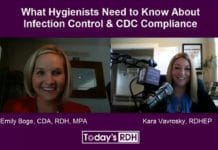Sensationalized headlines based on a preliminary scientific study have become more and more common. These headlines can often be misleading and cause misunderstanding and distrust among patients and health care professionals. They are also often a source of misinformation largely due to the misinterpretation of the preliminary study and/or the lack of transparency about the need for further studies to determine the study’s validity.
Recently, headlines about xylitol and cardiovascular risks have raised questions and concerns among dental professionals and likely many patients. In addition to being misleading, these headlines can also be fear-inducing. Dental professionals should understand what the studies that inspired the headlines say and what it means for our patients and the products dental professionals often recommend.
Xylitol and Cardiovascular Risks
Xylitol is the most recent substance used in dentistry to come under scrutiny and become a sensationalized headline. Xylitol is an effective option to manage xerostomia and reduce caries risk. It is also included in the Clinical Practice Guidelines for non-fluoride caries prevention agents supported by the American Dental Association (ADA).1-3
Recent headlines, such as “Common sugar substitute linked to increased risk of heart attack and stroke” and “Sugar substitute xylitol linked to heart attack, stroke risk,” have been making the rounds on social media and mainstream media outlets.4,5 Obviously, this will concern some dental patients using xylitol, or those who have had a dental professional recommend using xylitol to manage xerostomia or reduce the risk of dental caries. What does the study really conclude and how does it apply to xylitol use for dental health?
The key findings were reported as follows:6
- Xylitol was associated with major adverse cardiovascular events (MACE) at a three-year follow-up in a derivation and validation cohort.
- Xylitol enhanced multiple indices of platelet reactivation ex vivo and thrombus formation in a mouse model.
- Xylitol ingestion enhanced platelet responsiveness in humans.
I want to dive into these key findings and explain why this is not necessarily something to get too worked up about regarding using xylitol for oral health yet. I use the word “yet” because further studies may clarify things. In no way am I claiming this is the final decision on xylitol regarding MACE and its use for oral health purposes. However, using the evidence we have right now, let’s discuss it.
Xylitol Associated With MACE
Xylitol is associated with MACE at a three-year follow-up. The key word here is “associated.” This study did not identify a causal link because it was an observational study. Causal links cannot be established with observational studies. Nonetheless, observational studies can initiate further studies that could establish causality. Therefore, this is an important step in identifying what role, if any, xylitol might play in the increased risk of MACE.6,7
The cohort that was used to identify the association between xylitol and MACE were individuals with a history of chronic diseases, including diabetes, hypertension, history of cardiovascular disease (CVD), and history of myocardial infarction. Many reported being current smokers, and a significant number of the individuals who showed an increased risk of MACE had > 50% coronary vessel stenosis. Therefore, these individuals were already at an increased risk of MACE.6
Further, xylitol is produced endogenously, meaning that our own bodies produce low levels. According to the authors’ conclusion, the observational (validation) cohort with increased plasma levels of xylitol “represent variations in endogenous production/levels and not food intake.”6
The fact that the authors admit this increased serum level is not due to oral ingestion suggests there could be a third variable problem that has not been identified. A third variable problem is when an observed correlation between two variables (which we have here) can be explained by a third variable that has not been accounted for. Essentially, better-designed studies are needed to determine what other variables may be contributing to the increased serum levels observed in this cohort.8
This could also be an example of reverse causation because people with diabetes, obesity, CVD, etc., are more likely to use artificial sweeteners. Making an association statistically more likely.9
Platelet Reactivation in Mouse Model
Let’s move on to the mouse model. First and foremost, though animal studies are helpful, they cannot be extrapolated to apply to humans. There is a saying in clinical research, “mice lie, and monkeys exaggerate,” because animal models are preliminary and tell us absolutely nothing about what happens in a human.10
The authors admit that xylitol is poorly absorbed through the oral route in mice. Therefore, they increased plasma levels via intraperitoneal injections, which is an entirely different route of exposure when compared to humans. The fact that xylitol is not absorbed through the oral route in mice could indicate that injected xylitol’s distribution, metabolism, and excretion may differ greatly from oral exposure in humans. This is a serious limitation that should be considered when drawing associations from this animal model.6
Enhanced Platelet Responsiveness in Humans
Lastly, we have a healthy cohort (n = 10) that displayed enhanced platelet responsiveness after ingesting xylitol. What we discovered from this cohort is that ingesting xylitol increases the plasma levels of xylitol, and this increased plasma level appears to be associated with enhanced platelet responsiveness.6
This initially may feel like a compelling finding, but these individuals were not assessed to determine if this contributed to any increased risk of stroke or heart attack. Therefore, this finding isn’t all that important because it gives us no context as to how this might apply to the dose-response relationship the authors are trying to establish. As a matter of fact, it could mean that increased plasma levels of xylitol had no bearing on health outcomes whatsoever. There simply isn’t enough information to draw any conclusions.6
Additionally, the authors note that healthy individuals display a “rapid rate of xylitol excretion” with a return to near baseline (fasting) levels within hours following ingestion of a significant dietary dose (30 grams) of xylitol. This is important because, when used for oral health purposes, the doses are much lower and are fractioned. Fractioning doses significantly decrease adverse effects from most substances, and certainly that is true with xylitol.6
The recommended dose of xylitol for the prevention of dental caries is six to 10 grams a day, significantly less than the 30 grams used in this study. Furthermore, these doses are fractioned so the time that elapses between doses allows for rapid excretion, and the next dose will be at baseline. This study tells us nothing about low doses and fractioned doses.11
In Closing
The evidence presented in this study does not indicate the need to stop using xylitol in oral health products, nor does it indicate that dental professionals should abandon the recommendation for the use of xylitol for caries prevention and management of xerostomia. The authors also conclude by stating, “Further studies examining the cardiovascular safety of xylitol are warranted.”6
Sensationalized headlines are often misleading and inaccurate. Additionally, very few people read the entire article, and even fewer read the original source. It is a daunting task for someone with little to no science literacy to understand the shortcomings and limitations of studies. This is further complicated by the misinterpretation of findings that are widely spread through mainstream media and social media alike.
Therefore, it is the responsibility of those who have degrees in science to improve science literacy, especially when the topic at hand directly affects the area of your expertise. To be fair, many scientific articles are difficult to interpret if they are not in one’s field of study.
For example, the xylitol study cited for this article focuses on cardiovascular risks. Though dental hygienists understand risk factors associated with cardiovascular disease, some may feel ill-equipped to really dive into this study and highlight the limitations. This could lead to inaccurate clinical recommendations, such as no longer recommending xylitol as a caries prevention agent.
Interpreting scientific literature often takes a village. Surrounding yourself with people in different areas of science who are well-versed in how to interpret studies is a great way to learn more. Additionally, being open to being wrong about your original thoughts on the topic can lend to better understanding and growth in areas of science you may not be overly familiar with.
I hope this article will help you recognize sensationalized headlines and give you pause before you simply take what mainstream media and social media tell you as factual. Take the time to read the original source and critically assess what the study is really telling you. More often than not, you will find that the headline does not match the original study’s conclusion.
Before you leave, check out the Today’s RDH self-study CE courses. All courses are peer-reviewed and non-sponsored to focus solely on high-quality education. Click here now.
Listen to the Today’s RDH Dental Hygiene Podcast Below:
References
- Janakiram, C., Deepan Kumar, C.V., Joseph, J. Xylitol in Preventing Dental Caries: A Systematic Review and Meta-Analyses. J Nat Sci Biol Med. 2017; 8(1): 16-21. https://www.ncbi.nlm.nih.gov/pmc/articles/PMC5320817/
- Ship, J.A., McCutcheon, J.A., Spivakovsky, S., Kerr, A.R. Safety and Effectiveness of Topical Dry Mouth Products Containing Olive Oil, Betaine, and Xylitol in Reducing Xerostomia for Polypharmacy-Induced Dry Mouth. J Oral Rehabil. 2007; 34(10): 724-732. https://onlinelibrary.wiley.com/doi/10.1111/j.1365-2842.2006.01718.x
- Non-fluoride Caries Prevention Agents Guideline. (2011). American Dental Association. https://www.ada.org/resources/research/science-and-research-institute/evidence-based-dental-research/non-fluoride-caries-preventive-agents-guideline
- Mantel, B. (2024, June 6). Common Sugar Substitute Linked to Increased Risk of Heart Attack and Stroke. NBC News. https://www.nbcnews.com/health/heart-health/xylitol-linked-increased-heart-risk-reconsider-sugar-substitutes-rcna155688
- Smith, K. (2024, June 7). Sugar Substitute Xylitol Linked to Heart Attack, Stroke Risk. NewsNation. https://www.newsnationnow.com/health/xylitol-sugar-substitute-heart-attack-stroke-risk/
- Witkowski, M., Nemet, I., Li, X.S., et al. Xylitol is Prothrombotic and Associated With Cardiovascular Risk. Eur Heart J. Published online June 6, 2024. https://pubmed.ncbi.nlm.nih.gov/38842092/
- Mariani, A.W., Pêgo-Fernandes, P.M. Observational Studies: Why Are They so Important? Sao Paulo Med J. 2014; 132(1): 1-2. https://www.ncbi.nlm.nih.gov/pmc/articles/PMC10889453/
- Bobbit, Z. (2021, January 26). Third Variable Problem: Definition & Example. Statology. https://www.statology.org/third-variable-problem/
- Reverse Causation. (n.d.). Oxford Reference. https://www.oxfordreference.com/display/10.1093/acref/9780199976720.001.0001/acref-9780199976720-e-2332
- Tobias, E. (2023, September 8). Let’s Not Get Overexcited About any Mouse Study Used in Research. Multiple Sclerosis News Today. https://multiplesclerosisnewstoday.com/news-posts/2023/09/08/lets-not-get-overexcited-about-any-mice-study-used-research/
- Nayak, P.A., Nayak, U.A., Khandelwal, V. The Effect of Xylitol on Dental Caries and Oral Flora. Clin Cosmet Investig Dent. 2014; 6: 89-94. https://www.ncbi.nlm.nih.gov/pmc/articles/PMC4232036/












